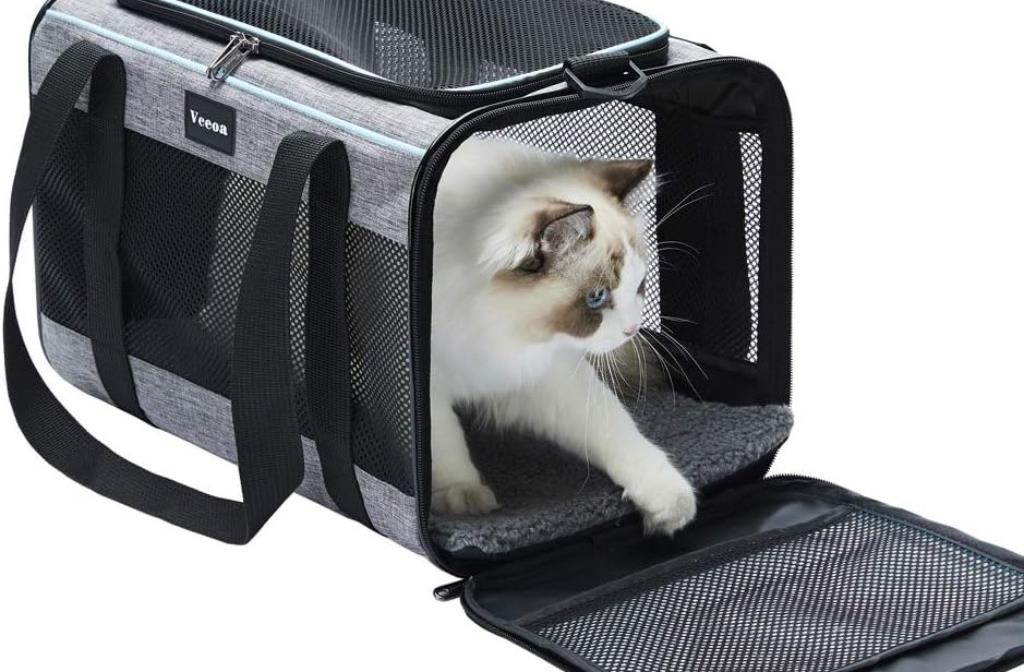Whether you’re heading to the veterinarian, embarking on a road trip, or flying across the country, having a reliable pet carrier for your feline friend is essential. Among the various options available, soft pet carriers for cats have gained popularity for their lightweight design and portability. However, like any pet accessory, they come with their own set of advantages and disadvantages. In this article, we’ll explore the pros and cons of using a soft pet carrier for cats to help you make an informed decision for your furry companion’s comfort and safety.
Pros: Soft Pet Carrier for Cats
1. Lightweight and Portable:
One of the most significant advantages of soft pet carriers is their lightweight construction. Made from materials like nylon, canvas, and polyester, these carriers are easy to carry, making them an excellent choice for trips where you need to move around frequently. They are particularly convenient for those who don’t want to lug around heavy, bulky carriers.
2. Comfortable:
Soft pet carriers often offer more comfort for your cat than hard-sided carriers. The soft sides allow for a bit of flexibility, allowing your cat to find a comfortable position during travel. Additionally, the soft, padded interior can make your pet feel cozy and secure.
3. Versatile:
Soft pet carriers come in various shapes and sizes, allowing you to choose one that suits your cat’s needs and your travel preferences. Some carriers have multiple entry points, top-loading options, or even expandable sections, providing more flexibility for both you and your cat.
4. Storage:
Unlike rigid carriers, soft pet carriers can be collapsed or folded when not in use, making them easy to store in tight spaces. This feature is especially beneficial for apartment dwellers or those with limited storage space.
5. Airline Travel:
Many soft pet carriers are designed to meet airline regulations for in-cabin travel. If you frequently fly with your cat, a soft carrier that fits under the seat in front of you can be a convenient and stress-free option.
6. Less Intimidating:
For some cats, the soft sides of the carrier might be less intimidating compared to the hard, enclosed spaces of traditional carriers. This can help reduce anxiety during travel, making the journey more comfortable for your feline friend.
Cons: Soft Pet Carrier for Cats
1. Limited Protection:
Soft pet carriers typically offer less protection in comparison to hard-sided carriers. In case of impact or pressure, they may not shield your cat as effectively. If you’re concerned about your cat’s safety during travel, especially in more rugged conditions, a hard-sided carrier might be a better choice.
2. Chew Resistance:
Cats who are anxious travelers might resort to chewing or scratching at the soft carrier’s materials. While some carriers are designed to be chew-resistant, determined cats might still be able to damage the carrier over time.
3. Cleaning Challenges:
Cleaning a soft pet carrier can be more challenging than cleaning a hard-sided carrier. Accidents, spills, or fur buildup can be harder to remove from fabric materials, potentially leading to lingering odors and hygiene issues.
4. Stability:
Soft carriers might lack the stability that rigid carriers provide. If your cat tends to move around a lot during travel, a soft carrier might sway or collapse, causing discomfort or distress.
5. Longevity:
While many soft carriers are durable, they might not be as long-lasting as high-quality hard-sided carriers. Sharp claws, frequent use, and exposure to various environments can lead to wear and tear over time.
6. Limited Visibility:
Some soft pet carriers have limited visibility for your cat. If your feline friend enjoys observing their surroundings, a carrier with mesh windows might provide a better travel experience.
Final Verdicta:
In conclusion, soft pet carriers for cats offer a balance between comfort, portability, and convenience. They are particularly suitable for short trips, in-cabin airline travel, and situations where lightweight and collapsible carriers are advantageous. However, they might not provide the same level of protection and durability as their hard-sided counterparts. Consider your cat’s temperament, travel frequency, and the nature of your journeys before making a decision. Whichever type of carrier you choose, prioritizing your cat’s safety, comfort, and well-being should always be the top priority.



